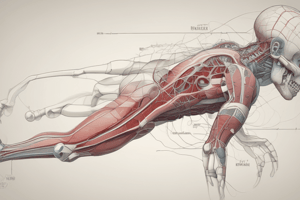Podcast
Questions and Answers
What is the primary function of the skeletal system?
What is the primary function of the skeletal system?
- To provide support and shape to the body (correct)
- To aid in digestion
- To produce blood cells
- To regulate body temperature
What type of bone tissue is a sponge-like inner structure?
What type of bone tissue is a sponge-like inner structure?
- Compact tissue
- Cartilaginous tissue
- Cancellous tissue (correct)
- Subchondral tissue
How many bones are in the adult human skeleton?
How many bones are in the adult human skeleton?
- 200
- 220
- 206 (correct)
- 210
What is the function of bones in terms of mineral storage?
What is the function of bones in terms of mineral storage?
What type of bones are found in the hands and feet?
What type of bones are found in the hands and feet?
What is the primary function of osteoclasts in the skeletal system?
What is the primary function of osteoclasts in the skeletal system?
During bone development, what process involves the direct conversion of mesenchyme structures to bone?
During bone development, what process involves the direct conversion of mesenchyme structures to bone?
What type of cells produce red blood cells, white blood cells, and platelets in the bone marrow?
What type of cells produce red blood cells, white blood cells, and platelets in the bone marrow?
What is the term for the process of maintaining bone as living tissue?
What is the term for the process of maintaining bone as living tissue?
What is the main function of the skeletal system?
What is the main function of the skeletal system?
Flashcards are hidden until you start studying
Study Notes
The Skeletal System: An In-Depth Look
The skeletal system, a crucial component of the musculoskeletal system, is primarily composed of bones and cartilage, interconnected by ligaments. It forms a protective framework for the body's tissues and supports various functions, including movement, protection, and mineral storage.
Bone Structure and Classification
There are three types of bone tissue: compact, cancellous, and subchondral. Compact tissue is the hard outer layer, while cancellous tissue is a sponge-like inner structure. Subchondral tissue is a smooth tissue that covers the ends of bones and is covered with cartilage.
Bones are classified by their shape, with long bones such as the femur and humerus, short bones like those in the hands and feet, flat bones such as the skull and ribs, and irregular bones like the vertebrae and pelvis. In total, there are 206 bones in the adult human skeleton, which includes axial bones (skull, vertebral column, ribs, and sternum) and appendicular bones (arms, shoulders, wrists, hands, legs, hips, ankles, and feet).
Functions of Bones
The skeletal system plays a vital role in our body's structure and function. It provides support and shape, protecting organs such as the heart and lungs. Bones also serve as a storage site for minerals, particularly calcium and phosphorus, which are essential for growth and repair. Soft bone marrow within certain bones is where blood cells are formed and stored.
Bone Cells
There are several types of bone cells, including osteoblasts, osteoclasts, osteocytes, and hematopoietic cells. Osteoblasts form new bone tissue and help in remodeling bones. Osteoclasts dissolve and reabsorb bone tissue. Osteocytes maintain bone as living tissue, while hematopoietic cells make red blood cells, white blood cells, and platelets in the bone marrow.
Growth and Development
Bone development begins in utero, with mesenchyme structures forming the embryonic skeleton. These structures then develop into bone through intramembranous ossification (direct conversion of mesenchyme structures to bone) or endochondral ossification (replacing cartilage with bone).
In summary, the skeletal system is a complex network of bones, cartilage, and ligaments that provide support, protection, and enable movement. Its structure and function are essential for maintaining the overall health and wellbeing of our bodies.
Studying That Suits You
Use AI to generate personalized quizzes and flashcards to suit your learning preferences.





